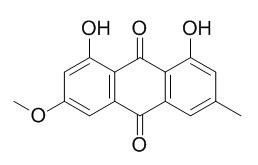Physcion
Physcion shows cytotoxic effect on human cervical carcinoma HeLa cells and its apoptosis induction in HeLa cells was investigated by the expressions of p53, p21, Bax, Bcl-2, caspase-9, and caspase-3 proteins. Physcion controls powdery mildew mainly through changing the expression of defence-related genes, and especially enhancing expression of leaf-specific thionin in barley leaves.
Inquire / Order:
manager@chemfaces.com
Technical Inquiries:
service@chemfaces.com
Tel:
+86-27-84237783
Fax:
+86-27-84254680
Address:
1 Building, No. 83, CheCheng Rd., Wuhan Economic and Technological Development Zone, Wuhan, Hubei 430056, PRC
Providing storage is as stated on the product vial and the vial is kept tightly sealed, the product can be stored for up to
24 months(2-8C).
Wherever possible, you should prepare and use solutions on the same day. However, if you need to make up stock solutions in advance, we recommend that you store the solution as aliquots in tightly sealed vials at -20C. Generally, these will be useable for up to two weeks. Before use, and prior to opening the vial we recommend that you allow your product to equilibrate to room temperature for at least 1 hour.
Need more advice on solubility, usage and handling? Please email to: service@chemfaces.com
The packaging of the product may have turned upside down during transportation, resulting in the natural compounds adhering to the neck or cap of the vial. take the vial out of its packaging and gently shake to let the compounds fall to the bottom of the vial. for liquid products, centrifuge at 200-500 RPM to gather the liquid at the bottom of the vial. try to avoid loss or contamination during handling.
Sci Rep.2018, 8(1):12970
Materials Today Communications2023, 37:107216
Antioxidants (Basel).2021, 10(1):112.
New Journal of Chemistry2019, 43:12538-12547
Appl. Sci.2020, 10,1304
Applied Biological Chemistry2022, 65(12)
Evid Based Complement Alternat Med.2022, 2022:1307173.
Front Pharmacol.2019, 10:1025
J Microbiol Biotechnol.2022, 32(2):141-148.
J of Engineering Science&Technology2018, 13(9):2820-2828
Related and Featured Products
Microbiol Res. 2014 Apr;169(4):255-61.
Physcion from marine-derived fungus Microsporum sp. induces apoptosis in human cervical carcinoma HeLa cells.[Pubmed:
24071573]
Recently, the relationship between apoptosis and cancer has been emphasized and the induction of apoptosis is recognized as one of the key mechanisms of anti-cancer agents. Marine-derived fungi are valuable sources of structurally diverse bioactive anticancer agents.
METHODS AND RESULTS:
In the present study, a marine-derived fungus, Microsporum sp. was cultured and an anthraquinone derivative, Physcion (11.8 mg) was isolated from the culture broth extract (1710 mg). Physcion has shown cytotoxic effect on human cervical carcinoma HeLa cells and its apoptosis induction in HeLa cells was investigated by the expressions of p53, p21, Bax, Bcl-2, caspase-9, and caspase-3 proteins. The Western blot analysis has revealed that Physcion could significantly induce cell apoptosis through down-regulating of Bcl-2 expression, up-regulating of Bax expression, and activating the caspase-3 pathway. Furthermore, Physcion induced the formation of reactive oxygen species (ROS) in HeLa cells.
CONCLUSIONS:
Collectively, these results suggest that Physcion could be a potential candidate in the field of anticancer drug discovery against human cervical cancer.
Pest Manag Sci. 2010 Jul;66(7):718-24.
Physcion, a natural anthraquinone derivative, enhances the gene expression of leaf-specific thionin of barley against Blumeria graminis.[Pubmed:
20205209 ]
Physcion is a key active ingredient of the ethanol extract from roots of Chinese rhubarb (Rheum officinale Baill.) that has been commercialised in China for controlling powdery mildews. The biological mechanism of action of Physcion against the barley powdery mildew pathogen was studied using bioassay and microarray methods.
METHODS AND RESULTS:
Bioassay indicated that Physcion did not directly affect conidial germination of Blumeria graminis Speer f. sp. hordei Marchal, but significantly inhibited conidial germination in vivo. Challenge inoculation indicated that Physcion induced localised resistance rather than systemic resistance against powdery mildew. Gene expression profiling of Physcion-treated barley leaves detected four upregulated and five downregulated genes (ratio >or= 2.0 and P-value < 0.05) by using an Affymetrix Barley GeneChip. The five upregulated probe sequences blasted to the same barley leaf-specific thionin gene, with significant changes varying from 4.26 to 19.91-fold. All downregulated genes were defence-related, linked to peroxidase, oxalate oxidase, bsi1 protein and a pathogenesis-related protein. These changes varied from - 2.34 to - 2.96. Quantitative real-time PCR data confirmed that Physcion enhanced the gene expression of leaf-specific thionin of barley.
CONCLUSIONS:
Results indicated that Physcion controls powdery mildew mainly through changing the expression of defence-related genes, and especially enhancing expression of leaf-specific thionin in barley leaves.
J Cancer Prev. 2014 Dec;19(4):273-8.
Induction of Cell Cycle Arrest and Apoptosis by Physcion, an Anthraquinone Isolated From Rhubarb (Rhizomes of Rheum tanguticum), in MDA-MB-231 Human Breast Cancer Cells.[Pubmed:
25574462]
Physcion is an anthraquinone from rhubarb (rhizomes of Rheum tanguticum) and has been reported to have anti-inflammatory, hepatoprotective, antifungal, and anti-cancer activities. However, the growth inhibitory activity against human cancer cells and the underlying molecular mechanisms have been poorly determined. This study was designed to investigate the anti-proliferative activity of Physcion by induction of cell cycle arrest and apoptosis in human MDA-MB-231 triple negative breast cancer cell line.
METHODS AND RESULTS:
MDA-MB-231 cells were treated with Physcion, and the anti-proliferative activity was evaluated by the sulforhodamine B assay. The mechanisms of action for the growth inhibitory activity of Physcion were evaluated by flow cytometry for cell cycle distribution, and by Western blot for the assessment of potential target proteins. Physcion showed a significant anti-proliferative activity against MDA-MB-231 human breast cancer cells. Flow cytometric analysis indicated that Physcion markedly induced the accumulation of cells in the G0/G1 phase and the increase of cell population in the sub-G1 phase. The G0/G1 cell cycle arrest by Physcion was associated with the down-regulation of Cyclin D1, Cyclin A, CDK4, CDK2, c-Myc and phosphorylated Rb protein expressions. The increase of sub-G1 peak by Physcion was closely correlated with the induction of apoptosis, which was confirmed by the induction of cleaved poly-(adenosine diphosphate ribose) polymerase, activation of Caspases, and suppression of Bid and Bcl-2 expression.
CONCLUSIONS:
The induction of G0/G1 cell cycle arrest and apoptosis might be one of the plausible mechanisms of actions for the anti-proliferative activity of Physcion in human breast cancer cells.



